Nigerian Army
| Nigerian Army | |
|---|---|
 Flag of the Nigerian Army | |
| Founded | 1960–present |
| Country |
|
| Type | Army |
| Size | 200,000 (2016)[1] |
| Headquarters | Abuja, Nigeria |
| Motto(s) | "Victory is from God alone" |
| Engagements |
Congo Crisis Nigerian Civil War First Liberian Civil War Sierra Leone Civil War Conflict in the Niger Delta Boko Haram insurgency Northern Mali War Invasion of the Gambia |
| Website | http://army.mil.ng/ |
| Commanders | |
| Commander-in-Chief | President Muhammadu Buhari |
| Chief of Army Staff | Lt General Tukur Yusuf Buratai [2] |
The Nigerian Army (NA) is the largest component of the Nigerian Armed Forces, and responsible for land warfare operations. It is governed by the Nigerian Army Council (NAC).[3]
Given its considerable investment in material, the Nigerian Army has generally been perceived as one of the better equipped fighting forces on the African continent.[4] It bears the brunt of the nation's security challenges, notably the Boko Haram insurgency.[5]
The original elements of the Royal West African Frontier Force (RWAFF) in Nigeria were formed in 1900. During the Second World War, British-trained Nigerian troops saw action with the 1st (West Africa) Infantry Brigade, the 81st and the 82nd (West Africa) Divisions which fought in the East African Campaign (World War II) and in the Far East.
In Nigeria, from a force of 18,000 in infantry battalions and supporting units, strength rose to around 126,000 in three divisions by the end of the Nigerian Civil War in 1970 .[6] In terms of doctrine, the task of the Federal Nigerian army did not fundamentally change: its task remained to close with and defeat an organised enemy.
Once among Africa’s strongest and a mainstay of regional peacekeeping, it has become a flawed force. The initially slow, heavy-handed response to the Islamist Boko Haram insurgency raised serious concerns, President Muhammadu Buhari has taken some steps to reverse the decline and has recorded significant gains against Boko Haram, but ongoing prosecution of former chiefs for graft have further deepened the military’s reputation as poorly governed and corrupt. The government and military chiefs, working with the National Assembly, civil society and international partners, need to do much more: implement comprehensive defence sector reform, including clear identification of security challenges; a new defence and security policy and structure to address them; and drastic improvement in leadership, oversight, administration and accountability across the sector. [7]
Until recently, the military was under-resourced, with comparatively low budgets, disbursed irregularly and unpredictably. From 2000 to 2008, its budget was less than 3 per cent of overall government expenditure. From 2009 to 2014, it increased to an average of 7.2 per cent of government spending ($5-$6 billion); but, as in the past, this was still allocated disproportionately to recurrent expenditures, leaving very little for crucial capital investment. [8]
The influence of individual personalities is generally greater in the armies of developing states, as they tend to have weaker institutional frameworks. Key personalities involved in Nigeria included then-Colonel Olusegun Obasanjo. Obasanjo is particularly important due to his efforts to reorganise his command, 3 Division, during the civil war to improve its logistics and administration. The reorganisation he instituted made the Division capable of carrying out the offensive that ended the civil war.
The Nigerian Army fought the civil war significantly under-resourced; Obasanjo's memoirs chronicle the lack of any stocks of extra equipment for mobilisation, and the "haphazard and unreliable system of procurement and provisioning" which lasted for the entire period of the war.[9] Arms embargoes imposed by several Western countries made the situation more difficult.
It currently has over 6,000 officers and 96,000 soldiers and that the 'Order of Battle 2010' plan called for this to grow to 18,966 officers and more than 190,000 soldiers.[10]
Structure
The Nigerian Army is governed by the Nigerian Army Council (NAC). The training centers are supervised by TRADOC (Training and Doctrine Command).[11]
Current formations include :
- 1st Division, headquartered in Kaduna [12]
- 3rd Armoured Division HQ is Jos [14]
- 81st Division (Amphibious) HQ in Lagos,[15]
- 6 Division HQ Port Harcourt [18]
Nigerian military forces abroad
In December 1983 the new régime of the Head of State of Nigeria, Major General Muhammadu Buhari, announced that Nigeria could no longer afford an activist anti-colonial role in Africa. Anglophone members of the Economic Community of West African States (ECOWAS) established ECOMOG, dominated by the Nigerian Army, in 1990 to intervene in the civil war in Liberia.[21] Smaller army forces had previously carried out UN and ECOWAS deployments in the former Yugoslavia, Angola, Rwanda, Somalia, and Sierra Leone.
The anti-colonial policy statement did not deter Nigeria under Generals Ibrahim Babangida in 1990 and Sani Abacha in 1997 from sending peacekeeping troops as part of ECOMOG under the auspices of ECOWAS into Liberia and later into Sierra Leone when civil wars broke out in those countries. President Olusegun Obasanjo in August 2003 committed Nigerian troops once again into Liberia,[22] at the urging of the United States, to provide an interim presence until the UN's force UNMIL arrived. Charles Taylor was subsequently eased out of power and exiled to Nigeria.
In October 2004, Nigerian troops deployed into Darfur, Sudan to spearhead an African Union force to protect civilians there.[23]
In January 2013, Nigeria began to deploy troops to Mali as part of the African-led International Support Mission to Mali.[24][25]
Nigeria claimed to have contributed more than 20,000 troops and police officers to various UN missions since 1960. The Nigeria Police Force and troops have served in places like UNIPOM (UN India-Pakistan Observer mission) 1965, UNIFIL in Lebanon 1978, the UN observer mission, UNIIMOG supervising the Iran-Iraq ceasefire in 1988, former Yugoslavia 1998, East Timor 1999, and in the Democratic Republic of the Congo (MONUC) 2004.
Nigerian officers have served as chiefs of defence in other countries, with Brigadier General Maxwell Khobe serving as Sierra Leone chief of staff in 1998-1999,[26] and Nigerian officers acting as Command Officer-in-Charge of the Armed Forces of Liberia from at least 2007.
Chiefs of the Nigerian Army
Following is a chronological list of officers holding the position of General Officer Commanding (GOC) or Chief of Army Staff (COAS).[27]
| Officer | Title | Period Served | Remarks |
|---|---|---|---|
| Maj Gen Kenneth G. Exham | GOC | 1956–1959 | Duke of Wellington's Regiment |
| Maj Gen Norman Foster | GOC | ||
| Maj Gen John Alexander Mackenzie | GOC | 1963 | |
| Maj Gen Sir Christopher Welby-Everard | GOC | 1963–1965 | Last British GOC |
| Maj Gen Johnson Aguiyi-Ironsi | GOC | 1965–1966 | Later military ruler |
| Lt Col Yakubu Gowon FSS | COAS | January 1966 - July 1966 | Later military ruler |
| Lt Col Joseph Akahan OFR FSS | COAS | May 1967 - May 1968 | |
| Maj Gen Hassan Katsina rcds psc | COAS | May 1968 - January 1971 | |
| Maj Gen David Ejoor | COAS | January 1971 - July 1975 | |
| Lt Gen Theophilus Danjuma | COAS | July 1975 - October 1979 | |
| Lt Gen Ipoola Alani Akinrinade CFR FSS | COAS | October 1979 - April 1980 | |
| Lt Gen Gibson Jalo CFR FSS JSS | COAS | April 1980 - October 1981 | |
| Lt Gen Mohammed Inuwa Wushishi CFR FSS | COAS | October 1981 - October 1983 | |
| Maj Gen Ibrahim Babangida | COAS | January 1984 - August 1985 | Later military ruler |
| Lt Gen Sani Abacha GCON, DSS mni | COAS | August 1985 - August 1990 | Last military ruler |
| Lt Gen Salihu Ibrahim FSS FHWC | COAS | August 1990 - September 1993 | |
| Lt Gen Aliyu Gusau Mohammed DSS rcds | COAS | September 1993 - November 1993 | |
| Maj Gen Chris Alli CRG DSS ndc psc(+) | COAS | November 1993 - August 1994?? | |
| Maj Gen Alwali Kazir DSS Usawc psc(+) | COAS | August 1994 - March 1996 | |
| Lt Gen Ishaya Bamaiyi DSS Usawc psc(+) | COAS | March 1996-May 1999 | |
| Lt Gen Victor Malu DSS mni fwc psc | COAS | May 1999 - April 2001 | |
| Lt Gen Alexander Ogomudia | COAS | April 2001 - June 2003 | Later Chief of Defence Staff (CDS). |
| Lt Gen Martin Luther Agwai | COAS | June 2003 June 2006 | Later Commander of the United Nations African Union Mission in Darfur. |
| Lt Gen Owoye Andrew Azazi | COAS | 1 June 2006 - May 2007 | Later Chief of Defence Staff (CDS). |
| Lt Gen Luka Yusuf CFR GSS GPP DSO psc(+) fwc Msc | COAS | June 2007 - August 2008 | |
| Lt Gen Abdulrahman Bello Dambazau CFR GSS psc ndc fwc(+) PhD | COAS | August 2008 - September 2010 | |
| Lt Gen Onyabor Azubuike Ihejirika CFR GSS psc(+) fwc fniqs | COAS | September 2010 - January 2014 | |
| Lt Gen Kenneth Minimah GSS psc(+) fwc | COAS | January 2014 – July 2015 | |
| Lt-Gen Tukur Yusuf Buratai NAM GSS psc(+) ndc (BD) | COAS | July 2015 - Till Date | Commander Multinational Joint Task Force (May 2015 - July 2015) |
Army equipment
Despite a disproportionate emphasis on the materiel and sophistication of the Nigerian Armed Forces, and despite possessing some formidable hardware, the army has been hamstrung by technical deficiency and an exceptionally poor standard of maintenance.[28] Its overabundance of foreign suppliers, including Austria, Brazil, France, Germany, Italy, Sweden, Switzerland, Romania, the former Soviet Union, and the United Kingdom, has also complicated logistics. Calculating the size and scope of replacement inventories alone is impossible given the menagerie of equipment in use.[28]
The Nigerian Army maintains at least 82 different weapon systems and 194 types of ammunition, of 62 different categories, from 14 manufacturers worldwide.[28]
Infantry weapons
| Name | |
Type | Country of Origin | Notes | ||
|---|---|---|---|---|---|---|
| Handguns | ||||||
| Beretta 92[29] |  |
Semi-automatic pistol | |
|||
| Beretta M1951[30] | |
Semi-Automatic pistol | |
|||
| Browning Hi-Power |  |
Semi-Automatic Pistol | |
Some of Nigerian manufacture.[31] | ||
| Walther P5[29] |  |
Semi-Automatic Pistol | |
|||
| Submachine guns | ||||||
| Beretta M12[32] |  |
Submachine gun | |
Some of Nigerian manufacture.[33] | ||
| Heckler & Koch MP5[30] |  |
Submachine gun | |
|||
| Sa vz. 23 |  |
Submachine gun | |
|||
| Sten[4] |  |
Submachine gun | |
|||
| Sterling[30] | |
Submachine gun | |
|||
| Uzi[30] |  |
Submachine gun | |
|||
| Rifles | ||||||
| IWI Tavor[34] | 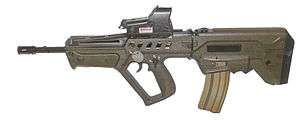 |
Bullpup assault rifle | |
|||
| Beryl M762[35] | |
Assault Rifle | |
|||
| FB Mini-Beryl[36] | |
compact assault rifle (carbine) | |
10 test units (wz. 1996C)[37] | ||
| M16A1[38] | 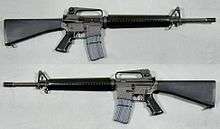 |
Assault Rifle | |
|||
| FN FNC[30] | |
Assault Rifle | |
|||
| Beretta AR70/90[30] | Assault Rifle | |
||||
| Daewoo K2[39] | |
Assault Rifle | |
|||
| OBJ-006 |  |
Assault Rifle | |
Produced as OBJ-006.[40][41] | ||
| AKM[42] | |
Assault Rifle | |
|||
| SIG SG 540[30] | |
Battle Rifle | |
|||
| NR1 | |
Battle Rifle | |
Local variant designated NR1.[43][44][45] | ||
| Heckler & Koch G3 |  |
Battle Rifle | |
Some of Nigerian manufacture.[46] | ||
| BM-59 |  |
Battle Rifle | |
Some of Nigerian manufacture.[47] | ||
| Vz. 52 rifle |  |
Semi-automatic rifle | |
|||
| Machine guns | ||||||
| RPK |  |
Light machine gun | |
|||
| Degtyaryov 1938/46 | |
Light machine gun | |
|||
| UKM-2000 |  |
General purpose machine gun | |
|||
| FN MAG |  |
General purpose machine gun | |
Some of Nigerian manufacture.[33] | ||
| Browning M2[30] | 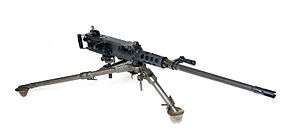 |
Heavy machine gun | |
|||
| Sniper rifles | ||||||
| Alex-338 |  |
Sniper rifle | |
|||
Missiles and Recoilless Rifles
| Name | |
Type | Country of Origin | Notes | ||
|---|---|---|---|---|---|---|
| Anti-tank missiles | ||||||
| Swingfire[48] |  |
Anti-tank missile | |
100 in stock.[49] | ||
| Recoilless rifles | ||||||
| M40[5] |  |
Anti-tank weapon | |
|||
| Carl Gustav |  |
Anti-tank weapon | |
30 in service.[30] | ||
| Rocket-propelled grenades | ||||||
| RPG-7 |  |
Anti-tank weapon | |
Some of Nigerian manufacture.[50] | ||
Armoured fighting vehicle
| Name | |
Type | Country of Origin | In Service | Notes | |
|---|---|---|---|---|---|---|
| Main battle tanks | ||||||
| T-72 |  |
Main Battle Tank | |
50[51] | Sourced from the Czech Republic. | |
| T-54/55 | 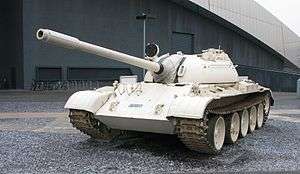 |
Main Battle Tank | |
24[5] | 50 delivered.[49] | |
| Vickers Tank | |
Main Battle Tank | |
108[5] | Mk III. | |
| AMX-30 | 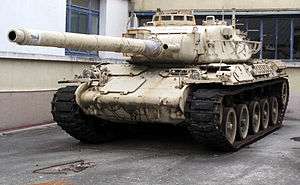 |
Main Battle Tank | |
16[5] | ||
| Reconnaissance vehicles | ||||||
| FV101 Scorpion | .jpg) |
Reconnaissance Vehicle | |
157[5] | ||
| FV107 Scimitar |  |
Reconnaissance Vehicle | |
5[5] | ||
| ERC-90 | |
Armoured Car | |
80[52] | 40 with Lynx turret. | |
| EE-9 Cascavel | |
Armoured Car | |
70[5] | Delivered in 1994.[49] | |
| Panhard AML |  |
Armoured Car | |
130[5] | AML-60 and AML-90 variants. | |
| Saladin | .jpg) |
Armoured Car | |
16[49] | ||
| Fox | .jpg) |
Scout Car | |
55[49] | ||
| Panhard VBL | .jpg) |
Scout Car | |
72[49] | ||
| Ferret |  |
Scout Car | |
25[52] | 40 delivered.[49] | |
| Infantry fighting vehicles | ||||||
| BMP-1 |  |
Infantry Fighting Vehicle | |
4[53] | BVP-1 variant. | |
| Armoured personnel carriers | ||||||
| Saurer 4K 4FA | .jpg) |
Armoured Personnel Carrier | |
250[5] | 300 delivered.[52] | |
| MT-LB | |
Armoured Personnel Carrier | |
67[49] | Sourced from Poland. | |
| Mowag Piranha |  |
Armoured Personnel Carrier | |
110[5] | ||
| BTR-4 |  |
Armoured Personnel Carrier | |
BTR-4 with Grom module | ||
| BTR-3 |  |
Armoured Personnel Carrier | |
47[49] | BTR-3U "Guardian" variant. | |
| BTR-70 |  |
Armoured Personnel Carrier | |
18[54] | ||
| BTR-60 | |
Armoured Personnel Carrier | |
6[55] | ||
| Saracen |  |
Armoured Personnel Carrier | |
10[5] | 20 delivered.[49] | |
| Saxon | 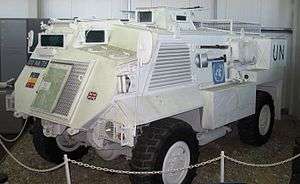 |
Armoured Personnel Carrier | |
75[49] | Serviceability doubtful.[5] | |
| Panhard M3 | 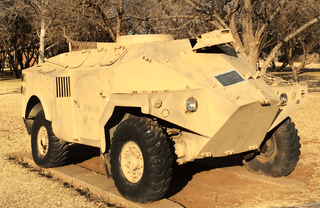 |
Armoured Personnel Carrier | |
18[5] | ||
| Infantry mobility vehicles | ||||||
| Igirigi | MRAP | |
Replaced the Pf1.[56] | |||
| Otokar Cobra |  |
Multipurpose Armoured Vehicle | |
204[5] | ||
| International MaxxPro |  |
MRAP | |
|||
| BAE Caiman |  |
MRAP | |
|||
| CS-VP3 |  |
MRAP | |
120 | ||
| Proforce PF1 |  |
MRAP | |
RG-34 Local variant designated Proforce Pf1.[57] | ||
| Casspir |  |
MRAP | |
5[5] | Casspir III variant. | |
| Reva |  |
MRAP | |
40 [58] | Mk III.[59] | |
| Plasan Sand Cat |  |
Composite armored vehicle | |
|||
| Light Armored Vehicles | ||||||
| SPARTAN MK.III | |
Light Armored Vehicle | |
[60] | ||
| INKAS LAPV | Light Armored Patrol Vehicle | |
[61] | |||
| Shorland | |
Armoured Car | |
Mk 3.[62] | ||
| Armoured Ambulances | ||||||
| FV104 Samaritan | Tracked Ambulance | |
||||
Logistics
| Name | |
Type | Country of Origin | In Service | Notes |
|---|---|---|---|---|---|
| KrAZ-6322[63] |  |
Utility Truck | |
Mine flail
| Name | |
Type | Country of Origin | In Service | Notes |
|---|---|---|---|---|---|
| BOZENA 5[64] | Unmanned ground vehicle | |
clearance of all conventional antipersonnel and antitank land mines and for IED removal assistance.[65] |
Utility Vehicle
| Name | |
Type | Country of Origin | In Service | Notes |
|---|---|---|---|---|---|
| Pinzgauer[66] |  |
High-Mobility All-Terrain Vehicle | |
||
| Land Rover |  |
Utility Vehicle | |
Some of local manufacture.[62] | |
| Haflinger |  |
Utility Vehicle | |
400[66] | |
| Toyota Hilux[67] |  |
Light Truck | |
||
| Tarpan Honker[68][69] |  |
Multipurpose Jeep | |
25 | |
| IVM G-12[70] | Special Purpose Vehicles [71] | |
|||
Artillery
| Name | |
Type | Country of Origin | In Service | Notes | |
|---|---|---|---|---|---|---|
| Self-propelled artillerys | ||||||
| Palmaria | |
Self-propelled Howitzer | |
25[52] | ||
| APR–40 | 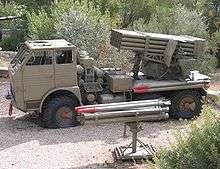 |
Multiple Rocket Launcher | |
30[5] | ||
| RM-70 | |
Multiple Rocket Launcher | |
6[53] | ||
| Mortars | ||||||
| L16 | 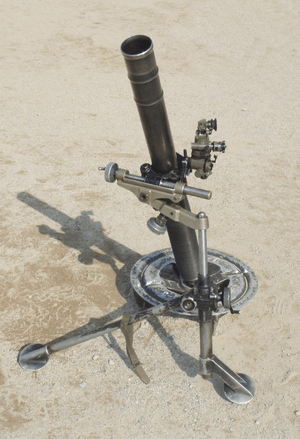 |
81mm Mortar | |
200[52] | Some of Nigerian manufacture.[72] | |
| Anti-tank guns | ||||||
| ZiS-3[52] |  |
Antitank Gun | |
|||
| Howitzers | ||||||
| D-30 | 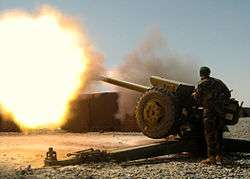 |
Howitzer | |
90[49] | ||
| D-74 | Howitzer | |
90[49] | |||
| M46 |  |
Howitzer | |
7[5] | ||
| D-20 |  |
Howitzer | |
4[5] | Delivered in 1992.[49] | |
| Haubits FH77 | |
Howitzer | |
24[52] | ||
| OTO Melara Mod 56 | 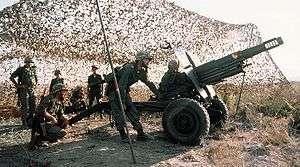 |
Howitzer | |
124[5] | 200 delivered.[49] | |
Air defence
| Name | |
Type | Country of Origin | In Service | Notes | |
|---|---|---|---|---|---|---|
| Self-propelled anti-aircraft weapons | ||||||
| ZSU-23-4 |  |
Self-propelled anti-aircraft gun | |
30[5] | ||
| Towed anti-aircraft guns | ||||||
| Bofors L/60 |  |
Towed anti-aircraft gun | |
12[5] | ||
| ZPU[52] |  |
Towed anti-aircraft gun | |
|||
| ZU-23-2 |  |
Towed anti-aircraft gun | |
350[5] | ||
| Surface-to-air missiles | ||||||
| Blowpipe | |
Surface-to-air missile | |
48[52] | ||
| Roland |  |
Surface-to-air missile | |
16[52] | Mounted on AMX-30 chassis. | |
| Strela 2 |  |
Surface-to-air missile | |
100[5] | ||
References
- ↑ , janes.com, 15 January 2016
- ↑ "nigerian-army.org". Retrieved 15 February 2015.
- ↑ Parliament of Nigeria. "Nigerian Armed Forces Act, 1994" (PDF). International Red Cross. Retrieved 12 March 2015.
- 1 2 McNab, Chris (2002). 20th Century Military Uniforms (2nd ed.). Kent: Grange Books. ISBN 1-84013-476-3.
- 1 2 3 4 5 6 7 8 9 10 11 12 13 14 15 16 17 18 19 20 21 22 23 24 Guy Martin. "Nigerian Armed Forces". Retrieved 15 February 2015.
- ↑ Scott report, Sunday Telegraph, 11 January 1970, via N.J. Miners, The Nigerian Army 1956-65, Methuen and Co. Ltd, London, 1971, p.229
- ↑ https://www.crisisgroup.org/africa/west-africa/nigeria/nigeria-challenge-military-reform
- ↑ https://www.crisisgroup.org/africa/west-africa/nigeria/nigeria-challenge-military-reform
- ↑ Olunsegun Obasanjo, My Command: An Account of the Nigerian Civil War, Heinemann, Ibadan/London/Nairobi, 1980, p.61
- ↑ http://www.janes.com/article/57231/nigerian-army-plans-to-double-in-size
- ↑ http://www.army.mil.ng/
- ↑ http://www.army.mil.ng/
- ↑ http://www.army.mil.ng/
- ↑ http://www.army.mil.ng/
- ↑ http://www.army.mil.ng/
- ↑ http://www.army.mil.ng/
- ↑ http://www.army.mil.ng/
- ↑ http://www.premiumtimesng.com/regional/south-south-regional/215772-created-new-nigerian-army-division-niger-delta-major-general.html
- ↑ http://allafrica.com/stories/201611280411.html
- ↑ http://www.army.mil.ng/
- ↑ "Waging War to Keep the Peace: The ECOMOG Intervention and Human Rights (Human Rights Watch Report, June 1993)". www.hrw.org. Retrieved 2017-02-06.
- ↑ "Nigerian troops off to Liberia". News24. Retrieved 2017-02-06.
- ↑ "BBC NEWS | Africa | Rwandan soldiers arrive in Sudan". news.bbc.co.uk. Retrieved 2017-02-06.
- ↑ "Nigeria expends N7bn on troops, logistics to Mali - Jonathan - Vanguard News". Vanguard News. 2013-01-30. Retrieved 2017-02-06.
- ↑ "U.S., Africa say Mali action counters growing Islamist threat". Reuters. 2017-01-23. Retrieved 2017-02-06.
- ↑ Dr Nowa Omoigui
- ↑ "Chronicle of Command". The Nigerian Army. Retrieved 2010-06-01.
- 1 2 3 John Olukayode Fayemi. "NThreats, Military Expenditure and National Security: Analysis of Trends in Nigeria's Defence Planning, 1970 - 1990". University of London. Archived from the original on 12 March 2015. Retrieved 12 March 2015.
- 1 2 Diez, Octavio (2000). Armament and Technology: Handguns. Lema Publications, S.L. ISBN 84-8463-013-7.
- 1 2 3 4 5 6 7 8 9 Jones, Richard D. Jane's Infantry Weapons 2009/2010. Jane's Information Group; 35 edition (27 January 2009). ISBN 978-0-7106-2869-5.
- ↑ Defense Industries Corporation of Nigeria Retrieved on 1 May 2013.
- ↑ Gander, Jerry (2002). Jane's Infantry Weapons 2002-2003. Jane's Information Group. pp. 214, 899–906. ISBN 0-7106-2434-4.
- 1 2 Defense Industries Corporation of Nigeria Retrieved on 1 May 2013.
- ↑ http://www.vanguardngr.com/epaper/2011/december/13122011/index.html
- ↑ "Tysiąc Beryli dla Nigerii - Altair Agencja Lotnicza". Retrieved 15 February 2015.
- ↑ http://www.altair.com.pl/news/view?news_id=17144
- ↑ http://www.altair.com.pl/news/view?news_id=17144
- ↑ Jane's Special Forces Recognition Guide, Ewen Southby-Tailyour (2005) p. 446
- ↑ "한국의 무기 이야기".
- ↑ "Nigeria to mass-produce Nigerian version of AK-47 rifles." Retrieved on 5 October 2008.
- ↑ "DICON – Defence Industry Corp. of Nigeria" Retrieved on 23 June 2012.
- ↑ Rottman, Gordon (2011). The AK-47 Kalashnikov series assault rifles. Great Britain: Osprey Publishing. ISBN 978-1-84908-461-1.
- ↑ "Licensed and unlicensed production of FN Herstal products, to August 2006" (PDF). Small Arms Survey. Retrieved 2010-04-10.
- ↑ "Nigeria - Arms Procurement and Defense Industries". June 1991. Retrieved 2010-04-10.
- ↑ "DOSSIER - The Question of Arms in Africa". Agenzia Fides. Retrieved 2010-04-10.
- ↑ Nigeria: Arms Procurement and Defense Industries. Retrieved on 5 October 2008.
- ↑ German small arms: The Nigerian connection. Retrieved on 5 October 2008.
- ↑ "Nigeria Armee nigeriane forces terrestres equipements vehicules blindes militaires information descr - Army Recognition". Armyrecognition.com. 2012-07-14. Retrieved 2012-08-17.
- 1 2 3 4 5 6 7 8 9 10 11 12 13 14 15 "Trade Registers". Armstrade.sipri.org. Retrieved 2014-04-20.
- ↑ Defense Industries Corporation of Nigeria Retrieved on 1 May 2013.
- ↑ "Nigeria takes delivery of T-72 tanks". IHS Jane's 360. Archived from the original on 2 February 2015. Retrieved 10 March 2015.
- 1 2 3 4 5 6 7 8 9 10 Metz, Helen Chapin. Nigeria: A Country Study. pp. 336–349.
- 1 2 Guy Martin. "Recent Nigerian military acquisitions". Retrieved 30 March 2015.
- ↑ BTR-70 Report between 1992 and 2012
- ↑ "The Russian BTR-60PB 8×8 Wheeled Armoured Personnel Carrier - TankNutDave". TankNutDave. Retrieved 15 February 2015.
- ↑ Guy Martin. "Nigeria opens ballistic armour factory; showcases first indigenous APC". Retrieved 15 February 2015.
- ↑ Guy Martin. "Nigeria to unveil indigenous armoured personnel carrier". Retrieved 15 February 2015.
- ↑ http://www.defenceweb.co.za/index.php?option=com_content&view=article&id=45776:new-vehicles-join-reva-lineup&catid=50:Land&Itemid=105
- ↑ RevaArmouredVehicles Review. "Recent Nigerian military acquisitions". Retrieved 4 May 2015.
- ↑ http://armstrade.sipri.org/armstrade/page/trade_register.php
- ↑ http://armstrade.sipri.org/armstrade/page/trade_register.php
- 1 2 Celestine Bassey & Charles Dokubo. Defence Policy of Nigeria: Capability and Context (2011 ed.). AuthorHouse Publishing. pp. 144–146. ISBN 978-1-4567-3156-4.
- ↑ Ukrainian Defense Review. "KRAZ Trucks on Military Service". Retrieved 4 May 2015.
- ↑ https://www.naij.com/1077090-nigerian-army-acquires-sophisticated-military-equipment-fight-boko-haram-pho.html
- ↑ http://www.bozena.eu/general-b5/
- 1 2 Constantin Kiesling. "Steyr Puch Haflinger TDC - Nigeria". Retrieved 15 February 2015.
- ↑ "The Official Website of the Government of Ekiti State, Nigeria » Fayemi donates 2 Hilux pick-up to the Army". The Official Website of the Government of Ekiti State, Nigeria. Retrieved 15 February 2015.
- ↑ https://twitter.com/RemigiuszWilk/status/773941918422228992
- ↑ https://twitter.com/RemigiuszWilk/status/774549277171445760
- ↑ http://www.defenceweb.co.za/index.php?option=com_content&view=article&id=46311:nigerian-army-operating-locally-made-ivm-g-12-special-purpose-vehicles&catid=50:Land&Itemid=105
- ↑ http://naijanewsupdate.com/2016/11/19/photos-innoson-delivers-1st-made-in-nigeria-vehicles-to-military/
- ↑ Defense Industries Corporation of Nigeria Retrieved on 1 May 2013.
